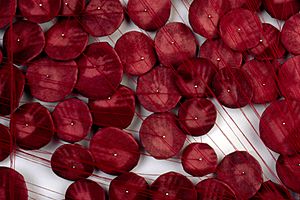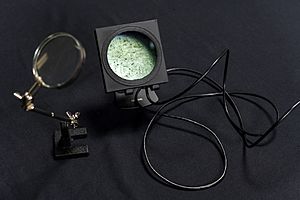Nene Humphrey facts for kids
Nene Humphrey (born March 18, 1947) is an artist who lives and works in New York. She creates art using many different types of materials and methods. Her work often explores ideas about the human body, dealing with loss, and how our brains handle emotions. She also finds beauty in everyday things. Nene Humphrey often combines art and science in her projects, which usually involve a lot of research.
Quick facts for kids
Nene Humphrey
|
|
|---|---|

Circling the Center, 2018
|
|
| Born | March 18, 1947 |
| Alma mater | St. Mary's College, Goddard College, York University |
| Known for | Sculpture Installation art Multidisciplinary Art |
| Movement | Contemporary art Feminist art |
| Awards | Anonymous Was A Woman Award |
Contents
Early Art (1980s)
In the 1980s, Nene Humphrey became known for her sculptures. She made them from materials like wax, plaster, wood, and wire frames. These sculptures hinted at the human body without actually making exact copies of it.
After a back injury in 1980, she started making drawings and sculptures that looked like spines. These artworks explored the feelings between what's inside us and what's outside, and between our physical bodies and our thoughts.
Her sculptures often had textures that felt like skin. She created these by repeating actions over and over, showing the artist's own hand in the work. Humphrey's art was influenced by a style called Minimalism, which uses simple shapes. But she also looked at it in a new way, similar to artists like Eva Hesse.
Breathing Wall Series
Her series called Breathing Wall for Vesalius (1985–86) showed an abstract and touchable view of the body. These sculptures hung on walls and mixed stiff wires with softer, vessel-like shapes. They showed the difference between the hard parts of her body, like her spine, and the soft, flexible muscles. These abstract sculptures were inspired by how the human body works. If you look closely at these pieces, you can see textures that are both soft and rough, as if the surface has been worn away or "scarred."
During this time, Nene Humphrey became interested in how our brains and emotions create memories. This interest would become very important in her later artworks.
Art in the 1990s
In the 1990s, Nene Humphrey's interest in touch and women's experiences grew. She started exploring handcrafts done at home. She focused on how the body leaves marks, and how we leave marks on things when we sew, clean, sweep, or braid. As art writer Nancy Princenthal said in 1996, "everything in Humphrey’s work is centered around tactility, beginning in handwork and resulting in a poeticized breed of manual objects." This means her art was all about touch and making things by hand.
Spoons (1994-1998)
Starting in 1994, Nene Humphrey began a series of artworks with her mother. Her mother was a homemaker, and Humphrey had felt disconnected from her mother's everyday work at home. One day, her mother offered to help in the studio. This made Humphrey realize how her own art was connected to what her mother had taught her as a child.
These artworks include spoons made by hand from copper. They are hammered and then hung up in detailed sculptures that look like mobiles or chains. For the Mother’s Spoons project, Humphrey shaped spoons from a material called celluclay. Then, she gave them to her mother to change with wire. The lines created by the wire looked like the movements of hands doing chores, like stirring or folding.
For Nene Humphrey, the spoon shape represents how a simple tool can feel like an extension of the hand. Spoons also symbolize feeding, care, and survival.
A Wild Patience (1996-1997)
Nene Humphrey continued to work with her mother and family in her A Wild Patience series. These artworks included many hands cast from celluclay. In a piece called Genealogy, she made casts of the hands of her immediate family: her mother, father, sister, brother, and herself. These objects were not perfect copies of hands. After being cast, they were sanded and burned, making them look almost like fossils.
The hands in A Wild Patience were made in a similar way. They were created from five different actions of Humphrey's mother's hands, each showing a specific activity done at home. The title of the work comes from a poem by Adrienne Rich. It refers to the strong spirit and humble effort needed for caregiving and homemaking.
Common Touch (1999)
In 1999, the Katonah Museum of Art asked Nene Humphrey to create a special artwork for their garden. This project continued her interest in hands as a symbol of work. She made five copper boxes that looked like garden beds. Then, she filled them with abstract terracotta hands. These hands were molded from the museum's staff, supporters, and volunteers.
Art from 2000s to 2010s
Loculus (1999-2001)
Nene Humphrey’s Loculus series continued her interest in the body and science. She used a process of repeating actions, like meditation. The Loculus artworks are made of many hand-stitched red circles. These circles are attached to a wall or standing structures with trails of thread. As art critic Ken Johnson wrote in The New York Times in 2001, the artworks look biological. He said the "hand sewn red discs clustered like rose petals or blood corpuscles." Some of Humphrey's Loculus works were shown in an exhibition called Site and Insight at MoMA PS1 in 2003.
Artist in Residence at NYU's LeDoux Lab (2005-2023)
Since 2005, Nene Humphrey has been an artist working at the LeDoux Neuroscience Laboratory at New York University. There, she works with Dr. Joseph LeDoux and his team. Humphrey wanted to explore how our brains process emotions. She also wanted to find ways to show this information in her art. She focuses on the science of emotions and a part of the brain called the amygdala. Her research at the lab has led to drawings, videos, and audio recordings. These often become large art installations and performances. Her works include drawings made using a microscope, sound recordings of brain activity, and even her own MRI scans.
Working with people from different fields has become very important to Nene Humphrey. She has worked with a director named Mallory Catlett, and musicians like Roberto Carlos Lange and Matana Roberts. She has also collaborated with cellist Clare Monfredo and video and sound designer Simon Harding.
Circling the Center (2008-2019)
After her husband passed away in 2006, Nene Humphrey started a big project called Circling the Center. This project explored the feelings of grief and how mourning affects the brain. She was inspired by Victorian mourning braiding, a tradition where people braided hair or other materials to remember loved ones. Her artwork connects the patterns created by this braiding to her drawings of the amygdala. To help with the loneliness of grief and bring back the community feeling of mourning rituals, Humphrey created multi-media installations and performances. These included all her research interests.
The first version of this project was shown at Lesley Heller Gallery in 2009. It was called The Plain Sense of Things. This installation included sculptures of braided wire on the walls. A critic from The New York Times, Holland Cotter, wrote that the exhibition showed "Order and chaos do battle here."
From 2009 to 2017, Humphrey presented Circling the Center as a performance several times. She invited the audience to join in a shared act of remembrance. These performances featured a circle of people braiding wire, following old instructions that were spoken aloud. This ritual was made bigger with film images, animated MRI scans, live video, and recorded sounds. These sounds included songs of lab rats and metronomes. These multi-media collaborations are a key part of Humphrey's recent work.
Transmission (2018)
The exhibition Transmission was shown at Lesley Heller Gallery in 2018. It showed "a moment where the braiding ritual has ended but the process of mourning remains." This means it explored how grief stays with us, both in the physical objects used in the ritual and in the less clear space of the brain.
The exhibition included an installation that recreated the braiding setup Humphrey used in Circling the Center. It had video footage of past performances and an empty braiding table. There were also side tables showing the materials used for braiding, like spools of different types of wire.
A second version of Transmission was shown at the Elizabeth Foundation for the Arts in 2019. This version included a sound recording of a poem called “If You Were to Peer into the Mourner’s Skull” by Tom Sleigh.
Art in the 2020s
This Like a Dream Keeps Other Time (2020-)
Since 2020, Nene Humphrey has been exploring the complex and emotional world of dreams. She was inspired by a dream she had about learning to sing in her late husband's family church in rural Georgia. These artworks look at how dreams help with our mental health and well-being. Like in Circling the Center, Humphrey became interested in how shared activities, like singing, affect our emotions and bodies.
In 2023, a version of this work was shown at Catskill Art Space in Livingston Manor, NY. It included installations of Humphrey’s scroll drawings with photos and videos of the tiny amygdala from the LeDoux lab. In a piece called Searching (2021-2022), Humphrey shows these videos in boxes that look like scientific displays. She also includes magnifying glasses, letting viewers experience how she has been drawing for fifteen years.
Throughout the installation, a layered and repeating soundtrack plays. It was written and recorded by Matana Roberts. This music reminds us of call and response singing, connecting to the emotional and biological patterns shown in the art. According to Christina Albu, This Like A Dream Keeps Other Time helps us notice the connections between sounds, brain waves, and feelings. Being aware of these connections can help us heal and grow.
Awards and Recognition
Nene Humphrey has received many important awards for her art. These include the Watermill Foundation Award (2021), the Brown Foundation Fellowship at the Dora Maar House (2019, 2009), and the Agnes Gund Foundation Grant (2016, 2010). She has also received fellowships from The MacDowell Colony (2011, 2008, 1978) and the Smithsonian Institution Artist Research Fellowship (2007). Other awards include the Anonymous Was a Woman Award (1999), the Rockefeller Foundation Fellowship (1986), and the National Endowment for the Arts Artist Grant (1983).
Art in Public Collections
Nene Humphrey's artwork can be found in many public art collections. Some of these include:
- Museum of Fine Arts Houston
- Smithsonian Institution
- High Museum of Art
- Herb and Dorothy Vogel Drawing Collection
- Philadelphia Museum of Art
- Robert Hull Fleming Museum
- Wilfredo Lam Contemporary Art Center





